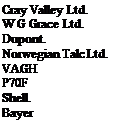IT finishing systems have long used acrylic polyurethanes to provide a tough abrasion resistant finish to computers, telecommunication equipment, etc. The substrates are often plastic, but can also be steel or aluminium. The requirements for exterior durability are less stringent than in ACE, but abrasion resistance requirements are even higher, due to the greater amount of handling these components receive.
The acrylic component can now contain reasonable amounts of styrene which reduces cost and the isocyanate component can be aromatic instead of the more expensive aliphatic variety. (Although IBM and Compaq have non — yellowing requirements that preclude the use of aromatic isocyanates.) Textured formulations with low gloss levels are popular decorative requirements in this industry, used to break up the hard lines of a computer box to make it more acceptable to the eye. Application is by conventional spray, often robotically applied in this high volume production industry. Above ambient or ambient cure and rapid handling time to permit sub assembly after the box is coated, means that acrylic is the only viable resin choice.
The textured effect is usually achieved by initially applying a coat of the PU formulation thinned to flow out in a conventional manner. Solvent flash off is followed by applying a second coat, unthinned and at reduced atomising pressure to give a ‘spattered’ effect. Again, the big acrylic polymer is desirable as the ‘spattered’ film must stand up with only a small amount of levelling whilst solvent flashes off and cure takes place. A typical formulation is shown below:
FORMULATION 5-11: PEARL WHITE TWO COMPONENT SPATTER FINISH —
ACRYLIC BASE COMPONENT
|
Synocure 867SD® Acrylic |
25.00 |
|
Methoxy Propyl Acetate (MPA) |
5.87 |
|
Butyl Acetate |
3.01 |
|
Solvesso 10 |
1.88 |
|
Gasil 23D® |
1.28 |
|
R960® ТіОг |
13.17 |
|
Micro Talc IT Extra® |
9.03 |
|
Solvesso 100 |
3.46 |
|
Vinylite VAGH® |
1.50 |
|
Vinnol P70F® |
9.03 |
|
Synocryl 867SD |
6.96 |
|
Xylene |
0.47 |
|
Butyl Acetate |
0.47 |
|
Epikote 836® |
0.28 |
|
Zinc Octoate |
0.53 |
|
Methyl Ethyl Ketone |
4.52 |
|
Total |
100.00 |
The Synocure 867SD® acrylic is high speed dispersed together with the solvents MPA amd butyl acetate, and precipitated silica and Ti02. This is pumped over a bead mill in one fast pass. Micro talc IT Extra is added with Solvesso 100, Vinylite VAGH, Vinnol P70F and additional Synocryl 867SA. Further raw materials achieve let down and viscosity adjustment.
Viscosity is measured with cone and plate (circa 2.5 poise) and with roto thinner (circa 5.0 poise) This gives a thixotropic index which is important with this type of formulation where such a degree of hold up is required in the spatter coat.
Desmodur N75® Bayer
The base to curing agent mixing ratio is 8/1. The mixed volume solids is 43%. The flash point of the mixed components is less than 21° C.
 Synocure 867SD Acrylic
Synocure 867SD Acrylic
Gasil 23D precipitated silica
R960 Ti02
Micro Talc IT Extra
Vinylite
Vinnol
Epikote 836
Desmodur N75
The acrylic is a general purpose industrial isocyanate curable acrylic. Hoescht, BASF and DSM amongst others have suitable equivalents.
The Gasil 23D is used to matt and more importantly to provide the thixotropy necessary for a spatter finish.
Talc is a good clean, cheap matting extender.
The vinyl resins increase flexibility and provide an improvement in adhesion to plastic substrates, particularly those which have been electrolessly nickel plated (e. g. for electromagnetic interference shielding).
The epoxy content also assists adhesion, this time to metal substrates.
Zinc is a milder OH/NCO catalyst than tin and it has less effect on pot life than tin. It accelerates the crosslinking adequately in all applications except for the most demanding.
The VOC for this coating is fairly high. As already described, the acrylic resin is important for the structure and rapid drying requirements in this industry, thus a high solids approach would be difficult. A waterborne latex formulation would work under the
current application conditions with the proviso that humidity controlled flash off zones are available.
Commercially available acrylics suitable for industrial protective coatings include:
Macrynal SM510 Macrynal SM500 Synocure 867SD Synocure 865SD Setalux С1151SS60 Setalux C1752XS65 Desmophen A160 Desmophen A365
 4 сентября, 2015
4 сентября, 2015  Malyar
Malyar  Опубликовано в рубрике
Опубликовано в рубрике 